The most important resource you’ll employ to deliver the project is people. They have to fit into the schedule and maintain the project budget. Defining what their roles and responsibilities are when executing tasks and delivering on the project goals is an important part of controlling the project.
How can you coordinate all the people who are involved in a project so they know what they’re doing and don’t block others from doing what they are assigned? Using a responsibility assignment matrix can help. An assignment matrix gives your project a team that gets things done.
What Is a Responsibility Assignment Matrix in Project Management?
A responsibility assignment matrix (RAM) is a project management chart used to identify and define the various people and organizations and outline each of their roles in working on tasks or delivering a part of the project.
Project managers use an assignment matrix to clarify what cross-functional teams do within the boundaries of the project and its numerous processes. Sometimes a responsibility assignment matrix is required when responding to a request for proposal (RFP).
ProjectManager manages project information by allowing teams to attach files directly to tasks, and our unlimited file storage keeps important project documents at your fingertips anywhere, anytime. Commenting on tasks can save time and tagging others in the project team creates a communication process that avoids the pitfalls of redundancies or unnecessary meetings.
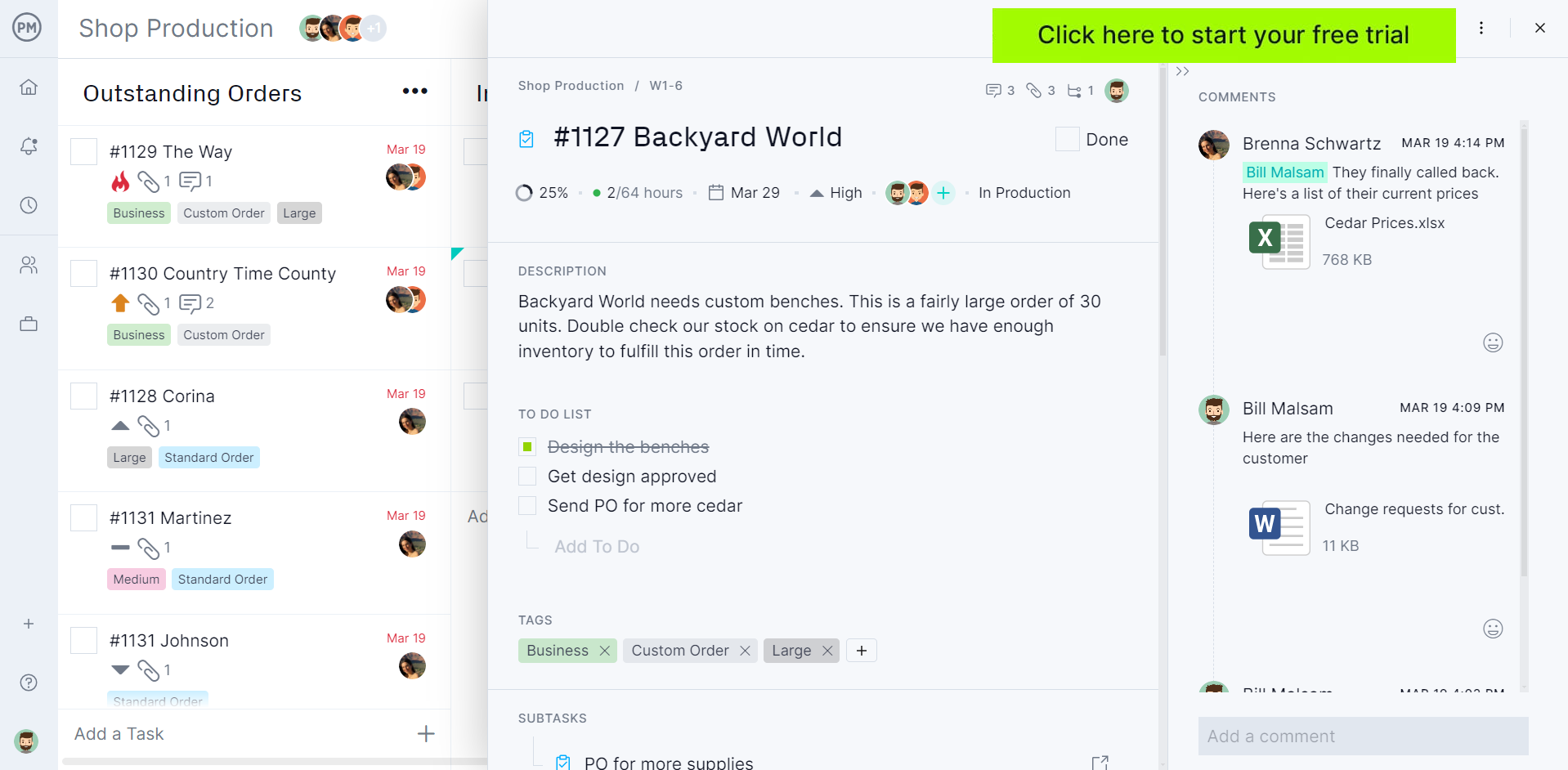
Types of Responsibility Assignment Matrix
Using a responsibility assignment matrix is important in project management as it clarifies roles and responsibilities among the project team. It helps ensure accountability, enhances communication and streamlines project execution. There is, however, more than one type of responsibility assignment matrix. Here are some examples of the more common ones.
RACI Matrix
A RACI matrix is a visual tool that defines four key roles and responsibilities of the project team. It determines who is responsible, accountable, consulted and informed, the definitions of which follow. Not only does this clarify roles, but enhances communication, increases accountability and provides efficiency in the project management process.
- Responsible: Notes who is responsible for executing the task, which is then assigned to them.
- Accountable: Notes who has decision-making authority and how that power is delegated throughout the project team.
- Consulted: Notes who can offer insight into the task, from team members to stakeholders.
- Informed: Notes who is updated on what in terms of progress and performance, as well as when and how this information is disseminated.
This creates a map of connections between activities and project team members. Depending on the size of the project, there can be several assignment matrices used for various project levels.
DACI Matrix
A DACI matrix is also used to clarify roles and responsibilities, but unlike the RACI matrix, this one is focused on who the decider or person who provides the final decision in the project is. It also identifies the people who are accountable for the task or deliverables, who are consulted during the decision-making process and who should stay informed on progress.
RASCI or RASIC Matrix
This variation on the RACI matrix stands for responsible, accountable, supportive, informed and consulted. It, like all responsibility assignment matrices, defines roles for the project team. It also enhances collaboration by highlighting who provides support, which fosters better teamwork and communication. This improves accountability as everyone knows what they’re responsible for.
CARS Matrix
The CARS matrix is a project management tool designed to clarify roles similarly to the other responsibility assignment matrix described above. It stands for contributor, which is the team responsible for specific tasks or deliverables; accountable, who is the person responsible for the successful completion of the task; review, the individuals who review the work done by the contributors and provide feedback; and, finally, support for those who support the contributors, which could be anything from resources, tools and expertise to assisting in the completion of tasks.
PACSI Matrix
Another responsibility assignment matrix is the PACSI matrix. This acronym stands for Performer, or the team member responsible for executing a specific task; accountable, again, the person accountable for that work’s successful completion; consulted, who is sought out during the decision-making process; supportive, those who provide support for the performers; and informed, who just need to stay updated on progress.
RACI-VS Matrix
A variation on the RACI matrix is the RACI-VS matrix. It’s the same as a RACI matrix but includes two other parts: validator and supportive. These are defined as the person or group responsible for validating the deliverables, ensuring they meet the required standards and specifications, for the former, and the latter being the individuals or teams that provide assistance or resources to help those responsible for completing the tasks.
RACI-Q Matrix
Another variation on the RACI matrix is this one, which is the same, except for the addition of a quality. This responsibility assignment defines who has the role of ensuring that the output meets the required quality standards for the project. This might include reviewing the work, conducting tests or providing feedback on deliverables.
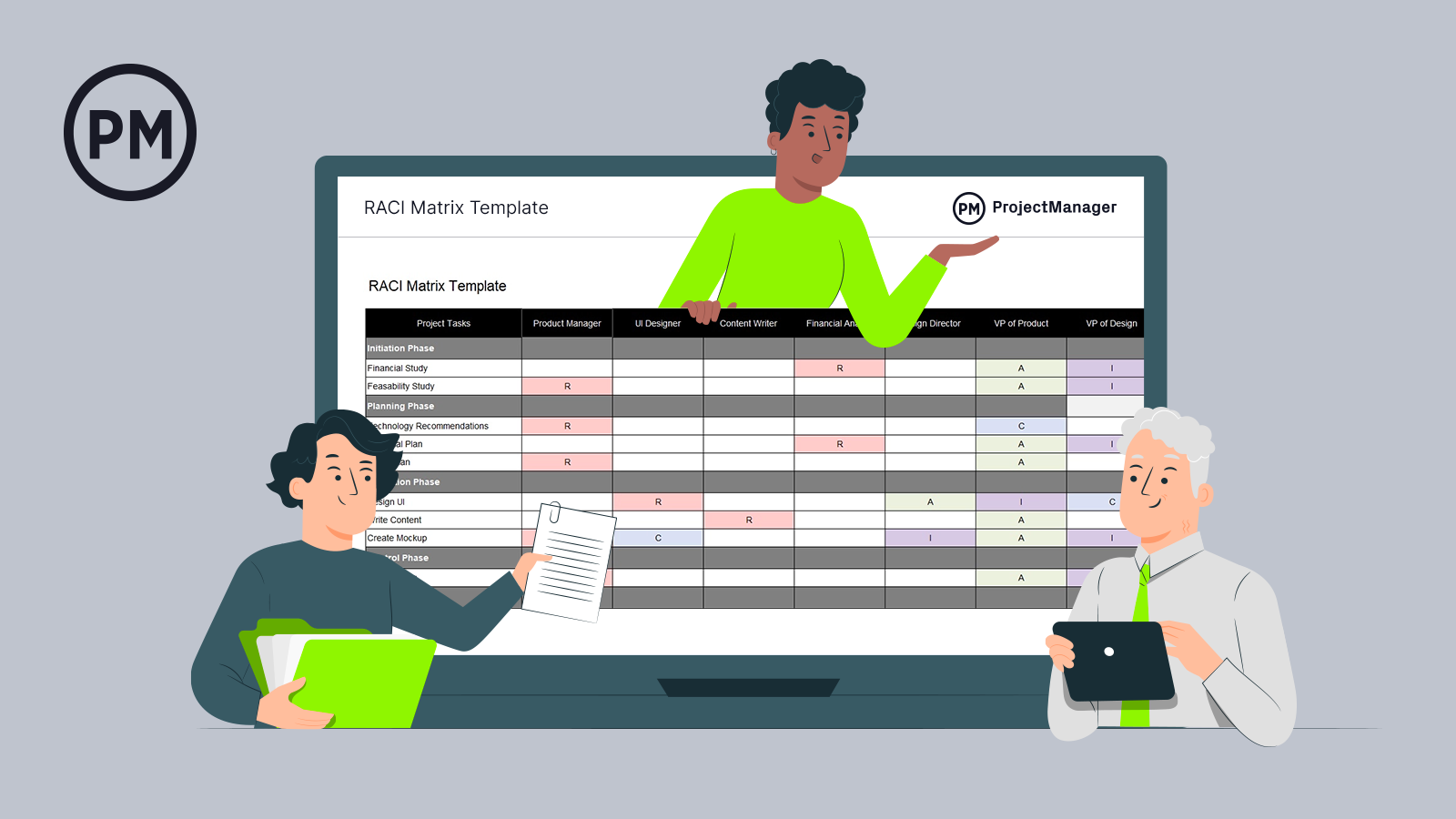
Get your free
RACI Matrix Template
Use this free RACI Matrix Template for Excel to manage your projects better.
Why Create a Responsibility Assignment Matrix?
The assignment matrix identifies what everyone on the team is responsible for, which means not only what their duties are, but how they participate in the project. Some will have defined tasks, others will offer help with work, and some are designated as decision-makers. These groups all have an identity and function within the project to help guide it towards a successful end.
Clear communication leads to more efficient projects. An assignment matrix facilitates better communication between team members and provides transparency by creating a system to make sure everyone is updated and always on the same page. Belaboring communications can bog down a project with too many pointless meetings and confusing interactions in which people try to understand what they’re supposed to be doing. Using the responsibility assignment matrix helps, but having project management software that connects teams in real time is ideal.
When Should a Responsibility Assignment Matrix Be Created?
The responsibility assignment matrix would be created at the start of the project. You’d want to have everyone on the project team aware of where they stand in terms of their involvement before they start executing tasks.
As much as its use is a preventative measure, it can be used prescriptively. If you’re deep into the project and things are not moving as planned, there could be communication gridlock. If team members are not in the loop, or misconstrue what they’re supposed to be doing, using a responsibility assignment matrix might untie those knots in the communication channel.
If there’s a problem with leadership overruling suggestions on how to advance the project and this is seen as a problem, the roles and responsibilities of the project team likely need refining. The responsibility assignment matrix defines who has the authority to make decisions and using it or revisiting can determine if the right people are in that position.
In fact, any of the definitions might need reexamining at any phase in the project. Perhaps tasks are falling behind schedule. This could be because team members aren’t aware of what tasks they own. Anytime a delay occurs, returning to the assignment matrix is a good first step, even if you went through the process as you should during the planning stage of the project.
How to Create a Responsibility Assignment Matrix
The actual making of a responsibility assignment matrix is not as difficult as getting everyone on board with what their roles and responsibilities are.
Therefore, you want to include your team in the process, get their input and eventually buy in without spending too much time and energy on the process. Follow these steps to make sure everyone is in agreement and you’ll have a successful responsibility assignment.
- Identify all the participants involved in the project, from team members to stakeholders and everyone in between.
- List all deliverables associated with the project. Use a work breakdown structure to make sure you don’t miss any.
- Meet with team members on how to execute the tasks to create the deliverables. Every task needs to be discussed in terms of the team’s responsibility and authority.
- Draft the responsibility assignment matrix using a table with the project tasks listed on the left-hand column. Across the top add the name of everyone in the project.
- Where the tasks meet the project team member, assign whether they’re responsible, accountable, consulted or informed.
- When completed, share the responsibility assignment matrix with the project team and stakeholders and hold a meeting if necessary to make sure everyone understands their part in the project. If you’re working in a shared space, print out a copy and post it.
Responsibility Assignment Matrix Example
The best way to understand how a responsibility assignment matrix (RAM) works is to take a look at an example of how it could be used in a real-life scenario. For this responsibility assignment matrix example, we’ll use a RACI matrix, which is the most commonly used type of RAM.
For this example, let’s imagine the construction of an apartment complex. A real estate developer is building this multi-story building, which involves key stakeholders, such as the project manager, lead architect, lead engineer, general contractor, subcontractors and the legal team.
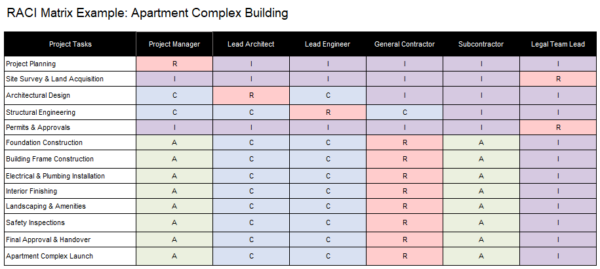
Let’s look at various parts of the project and define responsibilities. The project manager is responsible and accountable for planning but consults with the architect, engineer and legal team. The general contractor is kept informed during this process.
The legal team is responsible and accountable for site survey and land acquisition, while the project manager is consulted and the architect and engineer informed. The architect is responsible and accountable for the design process, with input from the project manager and engineer. The engineer is responsible and accountable for the structural design, consulting with the project manager and architect and keeping the general contractor informed.
While there are many more steps, such as permits, approvals, foundation and building frame construction, let’s jump ahead to the final approval and handover. At this point in the project, the project manager is accountable and responsible for this process, but the architect, engineer and general contractor are consulted and the legal team is kept informed.
Free Responsibility Assignment Matrix Template
Using a RACI template is a shortcut that sets up your team and the project for success. ProjectManager is more than an award-winning software that organizes tasks, teams and projects to streamline work and boost productivity, it’s also the online hub for all things project management.
Among the hundreds of blog posts, guidebooks and tutorial videos are dozens of free templates that can help you through every phase of your project’s life cycle. Using our free RACI template will help you guide all the project teams better, allowing them to know where they stand about the project and what their level of responsibility and accountability is.
Use it at the start of the project to avoid delays and untangle any communicative knots that are preventing the project from progressing as planned. To keep your project on track, download our free RACI template and get a head start on building a workable responsibility assignment matrix.

Best Practices When Making a Responsibility Assignment Matrix
Using our free RACI template is a good start, but you have to make sure you fill it in correctly. A responsibility assignment matrix is only as good as the effort put into creating it. Here are some best practices to apply when you’re in the process of building your assignment matrix.
- Involve the team: They’re the ones who will be executing the work. You want their input and buy-in to avoid any costly mistakes or time-consuming questions about what wasn’t made clear at the beginning of the project.
- Identify every single task: Identify all the tasks required to reach your final deliverable. Once you have that thorough list make sure that there is only one person on the team who is accountable.
- Update your RACI regularly: Make sure that each new one is marked as the most current version and is distributed to everyone on the team. There will be times when you’ll want to revisit the responsibility assignment matrix or personnel changes will require an edit.
- Share responsibility viably: One person shouldn’t have to shoulder the bulk of the responsibilities for the project and you want to give authority throughout the project team and not just among the very top management team.
- Optimize tasks: Managers can use the RACI matrix to see if too many team members have been assigned to a task. Maybe these workers could be spread out for greater productivity. There could be too many people listed as consulted, which slows down the process. The assignment matrix is endlessly useful.
How ProjectManager Helps You Manage Projects Better
ProjectManager is an online tool that connects everyone in real time to facilitate planning, monitoring and reporting on the project. It works to give everyone on the project team a job and the knowledge as to where they have authority and when to consult others, as well as defining the reporting process.
Let’s look at the people who are responsible, for example, the team who execute the project. Once invited into the software, you can share the project plan, assign them tasks, add detailed direction, add a deadline and tag for priority and more. The teams can then collaborate by attaching files and images to the tasks and commenting in real time to work better together.

Those who need to stay informed of the project can do so by also getting invited into the project and sharing plans and schedules with them. Stakeholders can stay updated with reporting features that can generate reports on project variance, cost, time and more with one click. Then share them as a PDF. Reports can even be quickly filtered to zero in on the data stakeholders are interested in.
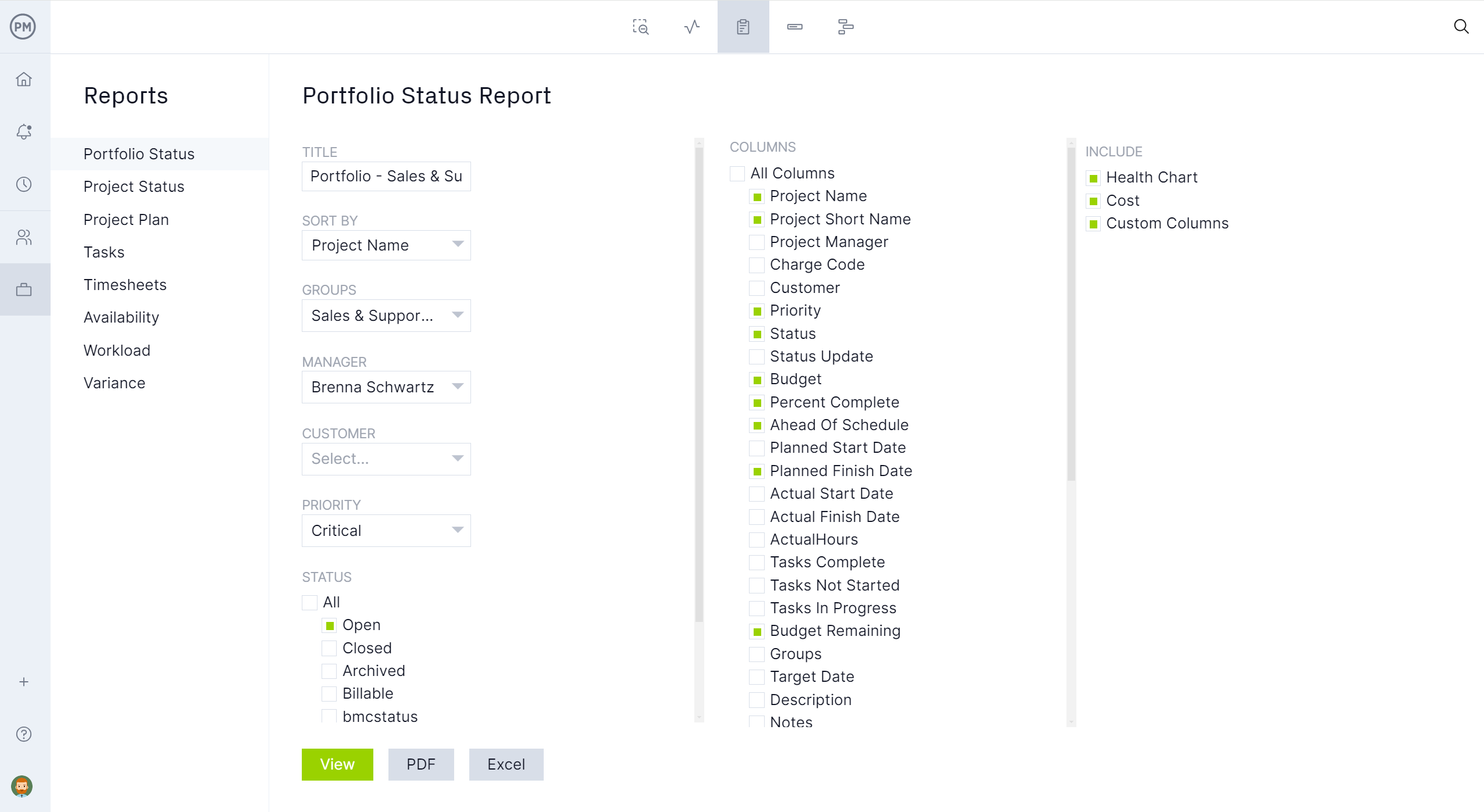
The responsibility assignment matrix can help you reallocate your resources when things aren’t progressing as planned. Use our software to get further insight. The resource management features include a workload chart that’s color-coded so it’s easy to see who has too many tasks and who can take on more work. Then you can simply reallocate those resources from the workload page to help your team work more productively.
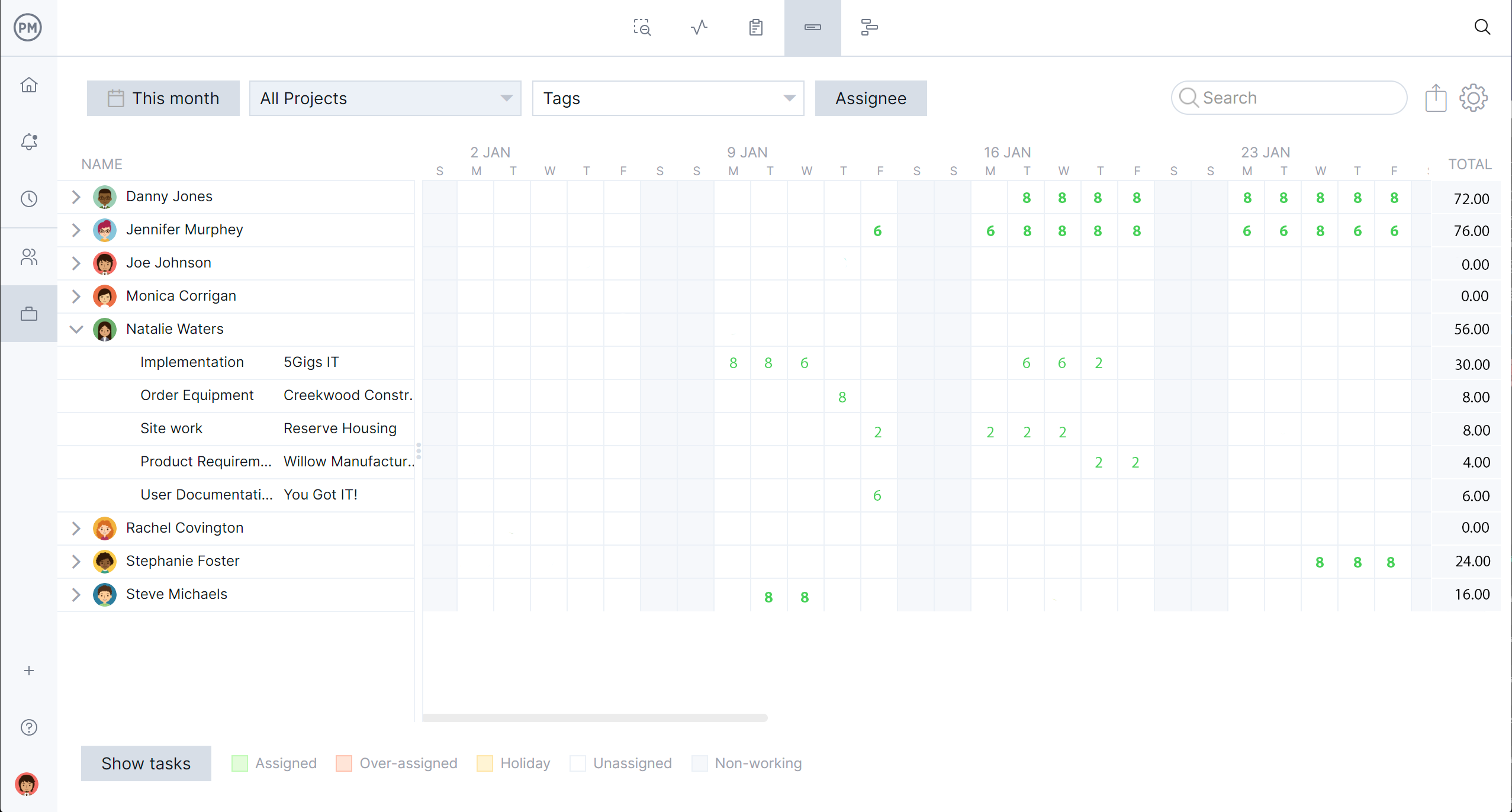
ProjectManager gets you organized and keeps your team focused on their tasks and stakeholders in the loop. Gain efficiencies throughout every aspect of your project’s life cycle with an online Gantt chart to schedule work and kanban boards, a visual workflow feature that provides transparency into production. All that and it’s on a collaborative platform to keep everyone connected. Try ProjectManager today for free.

